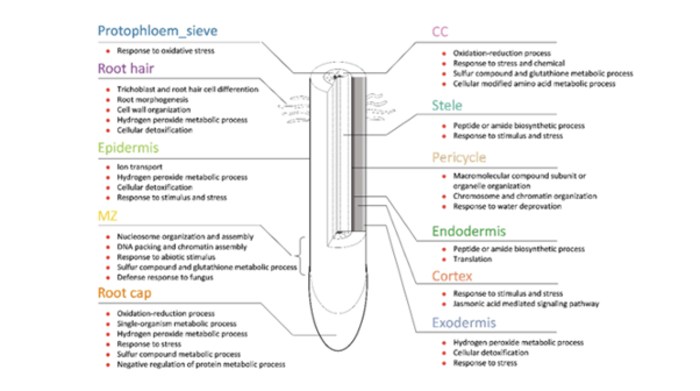Maize, or corn, is cultivated globally, as food, feedstock, and biofuel source, and is one of the most widely produced crops alongside wheat and rice. Today, the importance of maize as a grain is unrivalled and methods to increase crop yields, reduce farming costs, and ensure sustainable agriculture are critical.

Credit: Yongwen Qi from Guangdong Academy of Science
Maize, or corn, is cultivated globally, as food, feedstock, and biofuel source, and is one of the most widely produced crops alongside wheat and rice. Today, the importance of maize as a grain is unrivalled and methods to increase crop yields, reduce farming costs, and ensure sustainable agriculture are critical.
Increases in maize yield have been shown to be linked to nitrogen fertilizer use. But it has also been seen that their uptake of nitrogen fertilizer from the soil is inefficient, at only about 40–65%. Understanding what causes this inefficiency is important for improving crop growth economically and sustainably (less fertilizer use). However, traditional techniques for tissue dissection and analysis are labor-intensive and lack precision, making it difficult for scientists to obtain clear insights into cell types and characteristics.
Recently, a novel technique called single cell RNA-sequencing (scRNA-seq) has changed the game in cellular-level tissue analysis. A versatile technique, it has been applied to samples of human tissue, mice, rice, peanut, and other plants, revealing key gene expression patterns and cell developmental pathways.
Now, in a collaboration between the Institute of Nanfan & Seed Industry, Guangdong Academy of Science, China, and College of Agriculture and Biology, Zhongkai University of Agriculture and Engineering, China, scientists have used this tool to characterize maize roots. “The application of scRNA-seq to identify cell type-specific genes responsible for nitrogen uptake and processing brings new hope for optimizing root nutrient uptake ability in crops including maize,” says Prof. Yongwen Qi, who led the collaboration.
In their study, the team analyzed over 7000 cells from the root tips of seedlings grown on media with or without nitrate fertilizer. They identified and characterized 11 major cell types or tissues that were each present in starkly differing numbers (Figure). This reflected the high heterogeneity of maize root tips. Comparison of cells from seedlings grown in either media showed that across these cell types, there were 85 cell type-specific genes for nitrate-response, only some of them known for nitrate uptake and metabolism.
Further analysis revealed clues about the developmental pathways of various cells. For instance, it was found that root hair cells were derived from a subtype of the epidermal cell.
The scientists also compared cell types among maize and rice roots to find genes that are common and those that are differentiated, gaining insights into genes that could have been evolutionarily conserved across crop species. They found 57 root hair, 216 endodermis, and 80 phloem genes that are conserved.
The genes characterized in this study could serve as a roadmap for researchers looking to find ways of accurately controlling gene expression and variations in specific cell types or tissues, in maize or other crops. “Although not all cell types were captured, our results are a valuable resource for investigating cell types and the response of maize crops to nitrate fertilizer. This work also provides an example for the exploration of cell heterogeneity in a special tissue of a plant. Further, the genes characterized in this study could be targets for further analyses to genetically improve crops of various species. We hope this study can provide ideas and methods for gene isolation, controlling gene expression and plant characteristics, and even precision breeding,” says Prof. Qi.
Through their findings, Prof. Qi’s team have paved the way for new explorations in biotechnology and crop breeding. Particularly, this study presents a significant step towards more efficient and economical, but sustainable, maize crop growth, for a more golden future.
***
Reference
Authors: Xuhui Lia, Xiangbo Zhanga, Shuai Gaoa, Fangqing Cuia,b, Weiwei Chena, Lina Fana, Yongwen Qia,b
DOI: https://doi.org/10.1016/j.cj.2022.02.004
Affiliations
aInstitute of Nanfan & Seed Industry, Guangdong Academy of Science
bCollege of Agriculture and Biology, Zhongkai University of Agriculture and Engineering
About Professor Yongwen Qi
Dr. Yongwen Qi received his Ph.D. degree from China Agricultural University in 2007. Since then, he has carried out research on plant genetic diversity, molecular breeding, and new variety selection at the Nanfan & Seed Industry Institute of the Guangdong Academy of Sciences. So far, he has developed 21 new plant varieties and published about 60 articles.
Journal
The Crop Journal
DOI
10.1016/j.cj.2022.02.004
Method of Research
Experimental study
Subject of Research
Cells
Article Title
Single-cell RNA sequencing reveals the landscape of maize root tips and assists in identification of cell type-specific nitrate-response genes
Article Publication Date
9-Mar-2022
COI Statement
The authors declare that they have no known competing financial interests or personal relationships that could have appeared to influence the work reported in this paper.




